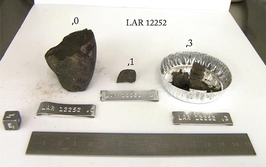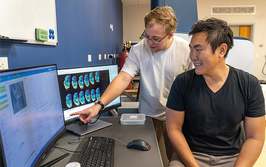Microscopy Meets Mass Spec for Spatially Precise Subcellular Detection
Researchers combine expansion microscopy and mass spectrometry imaging to map biomolecules in intact tissues at subcellular resolution
| 2 min read | News

TEMI mapping of lipid distribution across cerebellar layers. This image shows lipid species specifically enriched in three distinctive layers of the cerebellum: molecular layer, white matter layer and granular cell layer.
Credit: Zhang and Ding et al.
A new method, allowing untargeted, spatially resolved molecular profiling at the single-cell level – without the need for custom-built instruments – has been developed by researchers at Janelia Research Campus and the University of Wisconsin–Madison. The technique integrates tissue expansion with mass spectrometry imaging (MSI) to enable multiplexed detection of biomolecules such as lipids, metabolites, and proteins in intact tissues with unprecedented spatial precision.
Traditional MSI methods, while effective at visualizing biomolecular distributions, are typically limited by spatial resolution and therefore cannot resolve features smaller than tens of microns. To address this, the team adapted expansion microscopy – a technique that physically enlarges tissue samples using a swellable hydrogel – to preserve and isotropically expand samples prior to MSI. This approach, termed expansion mass spectrometry imaging (ExMSI), enhances spatial resolution by effectively “zooming in” on tissue structure without sacrificing molecular integrity.
"Knowing at each specific location what molecules are there and what is in the neighboring cells is very important for any kind of biological question," said Meng Wang, co-senior author of the study, in the team’s press release.
To support molecular annotation, the team combined matrix-assisted laser desorption/ionization (MALDI) mass spectrometry imaging with isotope-labeled standards and used high-resolution Fourier-transform ion cyclotron resonance (FT-ICR) mass spectrometry to verify their results. Computational workflows were also used to correct any distortion and register expanded images to anatomical references.
In their experiments, the researchers demonstrated that gradual, controlled expansion of tissue samples enabled spatial mapping of hundreds of molecules with subcellular resolution. Applied to the mouse cerebellum, the method revealed distinct molecular signatures across cerebellar layers – findings that would be obscured by conventional MSI. Among the detected molecules were diverse classes including lipids, peptides, proteins, and glycans.
The method requires no modification to existing mass spectrometry hardware and can be implemented with commercially available reagents and equipment, making it broadly accessible to laboratories already equipped for MSI. Moreover, the expansion procedure is compatible with standard MALDI workflows and allows multiplexed molecular detection without the need for affinity tags or labels. “We wanted to develop something that did not require specialized instruments or procedures, but can be broadly adopted,” Wang said.
The authors suggest that ExMSI may become a valuable tool for interrogating molecular changes in development, aging, and disease, particularly in complex tissues where understanding spatial relationships is critical.

















